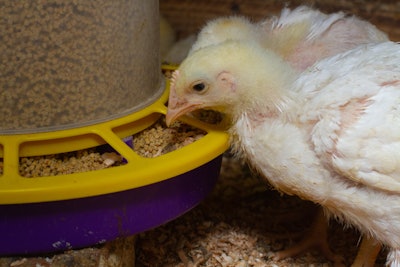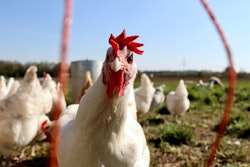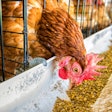
Various microbial agents frequently expose poultry flocks to a variety of disease outbreaks. There must be a nutritional program aimed at minimizing the disease effects under such adverse conditions, thereby improving production and economic returns.
Physical form of the diet
The physical form of the diet has a direct effect on the immune response of chickens. Birds fed whole wheat or sorghum develop a more active gizzard compared with those fed ground or cracked grains. The active gizzard acts as a natural defense mechanism against various microbial agents by better mechanical destruction of oocytes, sporocysts or sporozoites. Poorly developed gizzards become atrophied over time, if they have no large particles to grind, and the birds shed more pathogenic structures, leading to microbial infection.
Proteins
With most disease outbreaks, it may be necessary to increase the level of dietary protein, or at least maintain it within the recommended ranges. Protein is a potent regulator of the circulation of hormones such as insulin, glucagon, thyroxine and growth hormones, all of which affect the immune system and hence improve its disease-fighting capability.
In other cases, however, the supply of protein should be decreased. This is particularly useful under some disease conditions such as coccidiosis. If, in this case, the level of the dietary protein is maintained high, there will be an increased activity of enzyme trypsin in the small intestines of the bird. This will, in turn, lead to faster release of coccidia from their oocytes, which eventually become so active as to be less responsive to vaccination. The feeding regimen can also affect the severity of coccidiosis. Workers have observed that starving chickens before oral vaccination will reduce infection, probably due to lower excystation resulting from lowered trypsin levels induced by starvation.
Adjustment of the protein level up or down, or selection of the protein-feeding regimen at times of vaccination may not always be an adequate means of disease prevention. Some protein sources such as raw soybean, cottonseed meal and flax cake, contain varying amounts of antinutritional factors such as trypsin inhibitors, gossypol and glucosides, respectively. When ingested by the bird, these factors would then exert some damaging effects on the small intestine, thereby impairing the immune apparatus at this particular site, which exerts not only local but also systemic protective functions. Excessive use of such protein sources in the diet should, therefore, be avoided.
Fats
Dietary fat affects immunocompetence either by altering the cell membrane structure or by modulating the synthesis of prostaglandins, which play an important regulatory part in many biological processes, including the immune response. In one study, the resistance of chickens to disease agents such as E. coli and M. tuberculosis was linearly enhanced as the levels of lard or safflower oil were increased from 3% to 9%. Mortality associated with such diseases is also reduced with elevated levels of fat in the diet.
Under certain disease conditions such as coccidiosis, it will also be necessary to consider the type of fatty acids to be incorporated into the diet. Fat with a high content of saturated fatty acids may not be taken up into micelles. The digestion of this fat will be less impaired by the infection than fat with a high content of unsaturated fatty acids because they are easier to incorporate into micelles. This will, in turn, determine the extent to which weight gain and other fat-related production parameters will be affected by the disease.
Minerals and vitamins
Some mineral elements have the potential to regulate microbial populations in the gut. For their antimicrobial properties, copper and zinc are routinely fed at levels greater than the requirement to promote health and growth. The effects of different sources of these minerals may, however, vary. Dietary copper and zinc sources that are more soluble in the gastrointestinal tract affect intestinal physiology in the anterior parts of the small intestine (i.e. duodenum), whereas less soluble sources affect the posterior parts (i.e. jejunum). Therefore, the selection of dietary copper and zinc sources to modulate gut physiology may be based on the type and frequency of expected intestinal disease challenges.
Vitamins also affect the intestinal integrity and its associated immune system. Studies on vitamin A, for example, have reported higher mortality from E. acervulina and E. tenella in chickens fed vitamin A-deficient diets compared with those fed on diets supplemented with 8,000 IU of vitamin A per kg of feed. This result was attributed to the decreased number of T-helper cells in the intestinal epithelium of chickens when fed on diets deficient in vitamin A. The T-helper cells are responsible for orchestrating many other immune responses through cytokine secretion and interaction with other immune cells. This may provide a clue for the increased mortality of birds as the number of these cells decreases with vitamin A deficiency.
Birds should also receive more vitamin E if infected with E. coli. In a study with day-old broiler chickens, there was a linear increase in the production of the antibodies specific to the E. coli infection at 2 weeks of age when the level of vitamin E in the diet was increased from 150 IU/kg to 300 IU/kg. Similar responses were noted with parent stocks fed either 300 IU or 450 IU of vitamin E in the diet. At the higher level of the vitamin, there was an increased level of immunity against bacterial infections such as B. abortus in the offspring at 7 days of age.
Use of herbal products
Black cumin (Nigella sativa L.) is an herbal product that is rich in protein, fat, fiber and minerals. It also contains appreciable quantities of polyunsaturated fatty acids, representing 48-70% of their total oil content, with lesser proportions of monounsaturated fatty acids amounting to only 18-29%. Besides, the seeds contain considerable quantities of tocopherols and allied bioactive compounds such as phytosterols and thymoquinone which are important in enhancing the overall antioxidant capabilities of the body and act against various stresses, immune dysfunctions and other complications.
Green tea leaves (Camellia sinensis) have also been used in the field of therapeutic nutrition, mainly because of the presence of polyphenol derivatives such as carnitine and catechin, which play an important role in fatty acid oxidation and the production of ATP. The said derivatives also play an important role in the prophylaxis and/or treatment of neuropathic diseases, pancreatitis, fibroid tumors, etc. These effects, however, have so far been observed with laboratory animals only, and further work is needed to ascertain the potential role of tea leaves in the therapeutic nutrition of poultry.
Effects of pelleting
Pelleting maintains the normal structure and function of the gastrointestinal tract. The gizzards of birds fed pelleted diets were better developed compared with other birds whose gizzards were atrophied when fed ground diets since they had no hard particles to grind down. The well-developed gizzard can be regarded as a barrier in preventing pathogenic bacteria from entering the distal GIT. In pellet-fed birds, there is also an increased concentration of volatile fatty acids and reduced pH. The reduced pH has an antimicrobial effect on pathogenic bacteria entering the distal part of the gastrointestinal tract.
Water treatment
Acidifying drinking water for poultry with sodium bisulfate for the first seven days of life provides a second layer of protection to the lactic acid-producing bacteria (LAPBs) that are part of the crop’s normal ecology. This helps the newly hatched bird to maintain a low crop pH until it has established its population of stable LAPBs. A low crop pH also reduces the number of Salmonella, Clostridium or other harmful microflora that pass farther along the digestive tract and enables the bird to colonize with normal gut flora.
References available upon request.
















